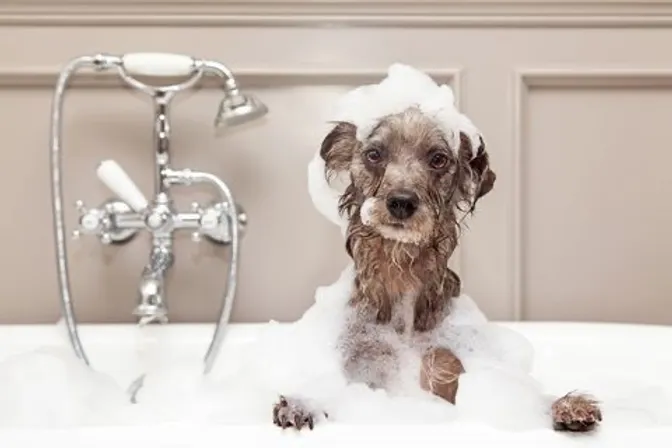When it comes to keeping our furry friends clean, puppy owners often wonder about the ideal frequency of baths. It’s a common misconception that our canine companions share our human preference for frequent cleanliness. In reality, most dogs, especially puppies, are indifferent to being clean. They find joy in outdoor activities like playing in the mud, oblivious to the concept of cleanliness.
However, as pet owners, we prefer to maintain a certain level of cleanliness, especially for dogs that spend most of their time indoors. No one wants a muddy puppy jumping on the couch or leaving dirt tracks across the floor. But it’s important to remember that a spotless puppy isn’t always a necessity.

How Often Should You Bathe Your Puppy?
Contrary to what you might think, dogs don’t require frequent baths. In fact, bathing them just a few times a year is often sufficient. Here’s why: Dogs have natural oils on their skin that play a crucial role in maintaining healthy skin and fur. Over-bathing can strip away these oils, leading to dry and itchy skin, a common issue in puppies.If you notice your puppy’s skin becoming dry or itchy, it might be a sign that you’re bathing them too often. While there’s no one-size-fits-all answer, most dogs appreciate a few baths a year. They might not always enjoy the bath itself, but they certainly feel refreshed and more comfortable afterward.
Choosing the Right Products
If your puppy’s itchy skin persists, it’s a good idea to consult your vet to rule out other issues. When it comes to bath products, opt for gentle, dog-specific shampoos. We’ve had great success with Burt’s Bees dog shampoo and various oatmeal-based shampoos, which are gentle on the skin yet effective in cleaning.
Remember, every dog is different, and the need for baths can vary based on their lifestyle and skin condition. While keeping your puppy clean is important, it’s equally crucial to maintain their skin’s natural balance for overall health and comfort.
Understanding Your Puppy’s Skin Health
It’s essential to pay attention to how your puppy’s skin reacts after a bath. Some puppies may have sensitive skin that reacts differently to various products or bathing frequencies. Monitoring your puppy’s skin condition after a bath can help you adjust your routine to suit their specific needs.
Bath Time as Bonding Time
While the primary goal of bath time is cleanliness, it can also be an excellent opportunity for bonding with your puppy. Many puppies may initially resist bath time, but with patience and positive reinforcement, it can become a pleasant experience for both of you. Use this time to gently massage your puppy, which can be soothing and help you spot any unusual bumps or changes in their skin or fur.
After the Bath: Drying and Grooming
Post-bath care is just as important as the bath itself. Ensure your puppy is thoroughly dried, as dampness can lead to skin irritation or infections. A good brushing after the bath helps remove loose fur and can prevent matting, especially in long-haired breeds.
Signs to Watch For
If you notice any persistent skin issues, such as excessive scratching, redness, or bald patches, it’s important to consult your veterinarian. These could be signs of allergies or other skin conditions that require professional attention.
In conclusion, while keeping your puppy clean is important, it’s vital to balance their hygiene with their overall skin health. By understanding your puppy’s specific needs and responding to them, you can ensure that bath time is a healthy, enjoyable experience for your furry friend.




